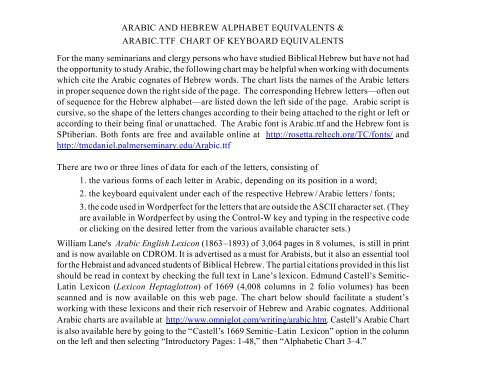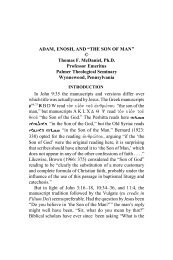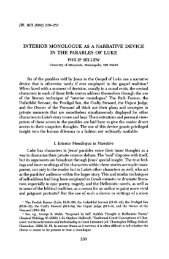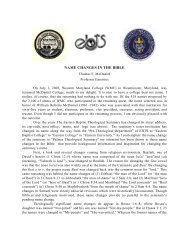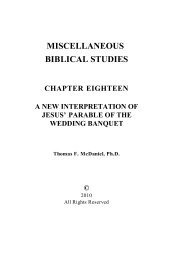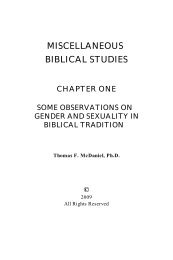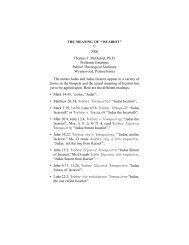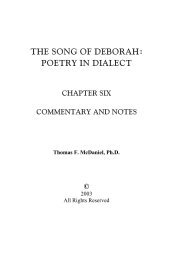the Hebrew & Arabic Alphabets and Font Charts
the Hebrew & Arabic Alphabets and Font Charts
the Hebrew & Arabic Alphabets and Font Charts
You also want an ePaper? Increase the reach of your titles
YUMPU automatically turns print PDFs into web optimized ePapers that Google loves.
ARABIC AND HEBREW ALPHABET EQUIVALENTS &ARABIC.TTF CHART OF KEYBOARD EQUIVALENTSFor <strong>the</strong> many seminarians <strong>and</strong> clergy persons who have studied Biblical <strong>Hebrew</strong> but have not had<strong>the</strong> opportunity to study <strong>Arabic</strong>, <strong>the</strong> following chart may be helpful when working with documentswhich cite <strong>the</strong> <strong>Arabic</strong> cognates of <strong>Hebrew</strong> words. The chart lists <strong>the</strong> names of <strong>the</strong> <strong>Arabic</strong> lettersin proper sequence down <strong>the</strong> right side of <strong>the</strong> page. The corresponding <strong>Hebrew</strong> letters—often outof sequence for <strong>the</strong> <strong>Hebrew</strong> alphabet—are listed down <strong>the</strong> left side of <strong>the</strong> page. <strong>Arabic</strong> script iscursive, so <strong>the</strong> shape of <strong>the</strong> letters changes according to <strong>the</strong>ir being attached to <strong>the</strong> right or left oraccording to <strong>the</strong>ir being final or unattached. The <strong>Arabic</strong> font is <strong>Arabic</strong>.ttf <strong>and</strong> <strong>the</strong> <strong>Hebrew</strong> font isSPtiberian. Both fonts are free <strong>and</strong> available online at http://rosetta.reltech.org/TC/fonts/ <strong>and</strong>http://tmcdaniel.palmerseminary.edu/<strong>Arabic</strong>.ttf .There are two or three lines of data for each of <strong>the</strong> letters, consisting of1. <strong>the</strong> various forms of each letter in <strong>Arabic</strong>, depending on its position in a word;2. <strong>the</strong> keyboard equivalent under each of <strong>the</strong> respective <strong>Hebrew</strong>/<strong>Arabic</strong> letters / fonts;3. <strong>the</strong> code used in Wordperfect for <strong>the</strong> letters that are outside <strong>the</strong> ASCII character set. (Theyare available in Wordperfect by using <strong>the</strong> Control-W key <strong>and</strong> typing in <strong>the</strong> respective codeor clicking on <strong>the</strong> desired letter from <strong>the</strong> various available character sets.)William Lane's <strong>Arabic</strong> English Lexicon (1863–1893) of 3,064 pages in 8 volumes, is still in print<strong>and</strong> is now available on CDROM. It is advertised as a must for Arabists, but it also an essential toolfor <strong>the</strong> Hebraist <strong>and</strong> advanced students of Biblical <strong>Hebrew</strong>. The partial citations provided in this listshould be read in context by checking <strong>the</strong> full text in Lane’s lexicon. Edmund Castell’s Semitic-Latin Lexicon (Lexicon Heptaglotton) of 1669 (4,008 columns in 2 folio volumes) has beenscanned <strong>and</strong> is now available on this web page. The chart below should facilitate a student’sworking with <strong>the</strong>se lexicons <strong>and</strong> <strong>the</strong>ir rich reservoir of <strong>Hebrew</strong> <strong>and</strong> <strong>Arabic</strong> cognates. Additional<strong>Arabic</strong> charts are available at http://www.omniglot.com/writing/arabic.htm. Castell’s <strong>Arabic</strong> Chartis also available here by going to <strong>the</strong> “Castell’s 1669 Semitic–Latin Lexicon” option in <strong>the</strong> columnon <strong>the</strong> left <strong>and</strong> <strong>the</strong>n selecting “Introductory Pages: 1-48,” <strong>the</strong>n “Alphabetic Chart 3–4.”
) " ! å é ç è ê ë Elif) " ! å é ç è ê ë) " ! 1,35 1,41 1,39 1,47 1,43 1,45b % & $ # Bab % & $ #t ) * ( ' Tat ) * ( '#$ - . , + The <strong>Arabic</strong> t (tha) became a š (shin) in <strong>Hebrew</strong>; Tha#$ - . , + but it becane a t (taw) in Aramaic <strong>and</strong> Syriac.g 5 6 4 3 ô ® Jimg 5 6 4 3 ô ®g 5 6 4 3 1,61 4,22 (ligatures mj <strong>and</strong> lj)x 1 2 0 / ò Ḥax 1 2 0 / òx 1 2 0 / 1,65 (ligature mh.)
x 9 : 8 7 ó H ax 9 : 8 7 óx 9 : 8 7 1,59 (ligature mh)d ; < Dald ; D alz = >r ? @ ì ï ö Rar ? @ ì ï ö1,55 1,53 1,63 (ligatures br tr tr )z A B Zayz A B#$ F E C D The <strong>Arabic</strong> s (sin) became a š (shin) in <strong>Hebrew</strong>. Sin#$ F E C D (The unpointed # is <strong>the</strong> # sign alone.)#& J I G H The <strong>Arabic</strong> š (shin) became a s (sin) in <strong>Hebrew</strong>. Šin#& J I G Hc N M K L ṢadN M K L
c R Q O P D . adR Q O P+ T S V U ṬaT S V Uc X W Z Y ẒaX W Z Y( ] ^ [ \ cAin] ^ [ \( a b _ ` G aina b _ `p f e d c õ Faf e d c õf e d c 1,83 (ligature of fy )q i j h g Qafi j h gk m n l k Kafm n l k
)k ù ú û ü (ligatures of kl on <strong>the</strong> right )& ù ú û ülk 1,73 1,67 1,69 1,71 (ligatures of k' on <strong>the</strong> left)l q r o p Æ ® Lamq r o p Æ ®q r o p 1,36 4,22 (ligatures of ly <strong>and</strong> lj on <strong>the</strong> right ))l § ã â à ä (ligatures of l' )) l § ã â à ä) l 4,5 4,6 1,77 1,29 1,33 1,31 (ligatures of l' )m v u t s Mimv u t sn y z x w { ¥ Nuny z x w { ¥y z x w { 4,12 (ligature of yn)
h Ä Å ~ | } Ç É HaÄ Å ~ | } Ç É1,30 1,34 ~ | } 1,38 1,40w Ñ Ö WaÑÖ1,56 1,62y £ £ á Ü Ya£ £ á Ü4,11 4,11 1,27 1,70î ¢ ñ ± õ Æ Modifications of YAî ¢ ñ ± õ Æ1,51 4,19 1,57 6,1 1,83 1,36¡ À Ã æ ø « ÷ Non-Letters¡ À Ã æ ø « ÷4,7 1,32 1,76 1,37 1,81 4,9 6,8í Ø ª º ¿ ¬ ¡ Õ Non-Lettersí Ø ª º ¿ ¬ ¡ Õ1,49 1,80 4,15 4,16 4,8 6,20 4,7 1,82


